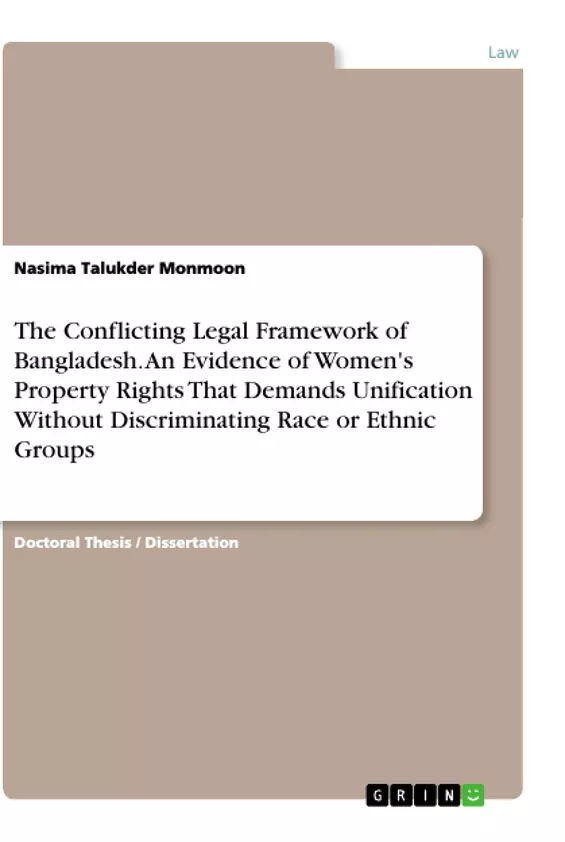The objective of this dissertation is to present a coordination of conflicting dynamics of the legal framework for women’s land rights in Bangladesh along with the consequential factors that generate discrimination among male and female. The constitution of Bangladesh has confirmed equal rights for all citizens without discriminating religion and gender, but the prevailing legislation for land and inheritance law has failed to ensure equality and justice. The ethnical groups in Bangladesh are Muslim, Hindu, Christian, Buddhist, and other minorities; all of them are individually religion biased inheritance law, which have deprived and discriminated women. Such religion based inheritance laws are not only conflicting with the constitutional principles, but also violated the constitutional supremacy.
This study identified that the introducers of the religions are the representative of patriarchy and they kept their gender interest on land by depriving and discriminating the females. The common consent of all the religions are the discrimination between male and female for land rights is a universal norms made by the God, they would like to validate their favouritism and inequity by keeping provision of getting equal heavenly glory in the eternity for females who obey religion orders. The women’s advancement in education and knowledge has given them sense, that life out of life does not carry any meaning, they demand equal rights in the earth- not to the heaven.
This study also acknowledged that no religion based inheritance law could ensure women’s equal property rights; thus, it is essential to introduce uniform property law for all citizens of Bangladesh based on gender equality that the original constitutional principal ensured regardless to the class, colour, race, and ethnic group.
Inhaltsverzeichnis (Table of Contents)
- Abstract
- Acknowledgement
- Chapter 1: Introduction
- 1.1 The Rationale for the Research
- 1.2 Research Question and Objectives
- 1.3 Research Design
- 1.4 Scope of the Study
- 1.5 Methodology
- 1.6 Limitations of the Study
- 1.7 Organization of the Study
- Chapter 2: The Conflicting Legal Framework
- 2.1 The Constitution of Bangladesh and Property Rights
- 2.2 Laws Relating to Property Rights in Bangladesh
- 2.3 The Role of Islam in Land Tenure and Inheritance Laws
- 2.4 The Role of Hindu Family Law in Land Tenure and Inheritance Laws
- 2.5 The Impact of the Conflicting Legal Framework on Women's Property Rights
- Chapter 3: Women's Property Rights in Bangladesh
- 3.1 Women's Land Rights in the Context of Traditional Practices
- 3.2 Women's Access to Property Rights under the Constitution
- 3.3 Women's Property Rights under the Inheritance Laws
- 3.4 The Impact of Patriarchy on Women's Property Rights
- 3.5 Women's Experiences and Perspectives on Property Rights
- Chapter 4: The Need for a Uniform Property Law
- 4.1 Arguments for a Uniform Property Law
- 4.2 The Role of Feminist Movements in Bangladesh
- 4.3 The Challenges to Implementing a Uniform Property Law
- 4.4 Policy Recommendations for Achieving Gender Equality in Property Rights
- Chapter 5: Conclusion
Zielsetzung und Themenschwerpunkte (Objectives and Key Themes)
This dissertation aims to critically examine the conflicting legal framework in Bangladesh, specifically focusing on how it impacts women's property rights. The study analyzes the constitution, legislation, and traditional practices related to land tenure and inheritance, highlighting the discrepancies and inequalities that exist. The dissertation ultimately argues for the implementation of a unified property law that ensures equal rights for all citizens regardless of gender or ethnic group.
- The conflicting nature of the legal framework in Bangladesh regarding women's property rights.
- The impact of religious-based inheritance laws on women's access to property.
- The role of patriarchy and traditional practices in perpetuating gender inequality in land ownership.
- The need for a uniform property law that promotes gender equality and addresses the existing disparities.
- The importance of feminist movements and advocacy in advocating for women's property rights.
Zusammenfassung der Kapitel (Chapter Summaries)
The dissertation begins by establishing the rationale behind the research, outlining the research questions, and detailing the methodology employed. The first chapter discusses the study's scope and limitations, along with the overall organization of the research. Chapter 2 delves into the intricacies of the conflicting legal framework in Bangladesh, examining the constitution, various laws related to property rights, and the influence of Islamic and Hindu family law. The chapter focuses on the discrepancies and contradictions inherent in the current legal system that hinder women's equal access to property. Chapter 3 focuses specifically on women's property rights, analyzing their position within traditional practices, their access to property under the constitution, and the impact of patriarchal structures on their land ownership. The chapter also explores the experiences and perspectives of women on property rights in Bangladesh. Finally, Chapter 4 argues for the implementation of a uniform property law, outlining the benefits and addressing the challenges involved in achieving gender equality in property rights.
Schlüsselwörter (Keywords)
The dissertation delves into the complexities of women's property rights in Bangladesh, emphasizing the conflicting legal framework, religious-based inheritance laws, the impact of patriarchy, and the need for a uniform property law. Key themes explored include gender equality, constitutional rights, land tenure, inheritance laws, feminist movements, and the importance of advocating for social justice. The dissertation employs quantitative and qualitative research methods, analyzing primary and secondary data sources to provide a comprehensive understanding of the issue.
- Citation du texte
- Nasima Talukder Monmoon (Auteur), 2011, The Conflicting Legal Framework of Bangladesh. An Evidence of Women's Property Rights That Demands Unification Without Discriminating Race or Ethnic Groups, Munich, GRIN Verlag, https://www.grin.com/document/924694



